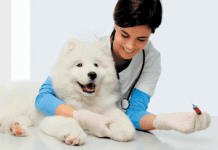Shaking: When to Worry; When Not to
If your dog keeps shaking her head, take her to the vet. She could be afflicted with anything from an ear infection to a neurological issue. But if she does full-body shakeouts, there’s nothing to be concerned about. It’s just her way of regrouping or transitioning from one activity to another.
Repeated Exposure to Something Scary Won’t Help Your Dog Adjust
Your dog is scared to death of the vacuum cleaner, but you assume she’ll get over it once she has seen you use it a few times. She won’t. If your dog has a specific fear, the only way to help her get past it is to expose her gradually to whatever she’s afraid of. In the case of a vacuum cleaner, that might mean keeping it out in the open for a while and letting her sniff it when she wants to, then perhaps moving to vacuuming in a room that’s far from where she generally hangs out and keeping the door closed while you do so.
If your pet is afraid of other dogs, walk her where you’re not likely to see any—or at least very few, and at a distance. Arrange a short introduction with a sweet, gentle dog who doesn’t engage in any roughhousing. Throw your dog and the other one treats and speak in encouraging tones, removing your pet from the situation if she gets too upset. Then try again another day.
You See a Beautiful Polished Floor. Your Dog Sees an Ice Skating Rink.
Sure, you may love the look of a gleaming hardwood or tile floor, but perhaps your dog equates stepping onto such a surface with the way one might see a treacherous foray onto the ice in slippery shoes.
On the Horizon: Dog Cancer Screening Via a Urine Sample
The molecules in a dog’s urine have a unique fingerprint, and researchers are finding that it can be used to detect—in minutes—whether a dog has cancer. There are blood tests for canine cancer, but they can be expensive, and you have to wait for a lab to come back with the results. Moreover, the results might be only about 60 percent accurate. With a urine test, researchers are finding results that are more than 90 percent accurate.
When $35 of Prevention is Worth More than $10,000 of Cure
Inoculation against a bacterial disease called leptospirosis is not considered a core vaccine, meaning you should discuss with your vet whether your particular dog is at risk. The offending bacteria particularly thrive in relatively warm climates with high average rainfall.
Which Sunscreen, and for Which Dogs?
Sunburn can especially affect thinly-furred dogs and is sometimes also a precursor to canine skin cancer. You can put a T-shirt on your pet, but certainly during the summer hours when sunlight is at its strongest—from about 9 AM to 3 PM—sunscreen may also be necessary on parts of his body that the cloth won’t cover, like the bridge of his nose and the tips of his ears. Some dogs, like those with short hair and pink skin (think Dalmatians or Chinese cresteds), would benefit from a sprayable sunscreen applied pretty much all over their bodies, with an SPF of at least 15. There is a commercial sunscreen approved for dogs called Dermoscent Sun Free.
If You and Your Dog Are Traveling by Air
More than 2 million pets travel by air each year, according to the U.S. Department of Transportation. If your canine family member is going to be one of them, it’s good to get him acclimated ahead of time.
When Eye Gook is Normal; When It’s Not
There’s whitish or clear gook in the inner corner of your dog’s eye. Should you be concerned? Nope. It’s a normal dog thing. Just put warm water on a cotton ball and wipe the lower lid to remove it.
Prison Puppies
We’re not talking here about canine prisons—puppy mills where dogs are kept in deplorable conditions. We’re talking about a program called Prison Puppies in which incarcerated men and women train puppies to become guide dogs and thereby help people in need. The program currently operates in prisons in Michigan and Minnesota.
Telemedicine for Fido, or In-Person Care?
The COVID pandemic led to more Zooming and FaceTiming, including for veterinary care. And it may be easy to assume that most people have come to prefer such virtual vet visits because it’s more convenient than taking your dog to the doctor. But they don’t.
Dogs Dig It
Different breeds of dogs dig for different reasons. Terriers, originally bred to dig for varmints that burrow into the ground, might dig fast and furiously in the dirt — or bed linens — to work through their hereditary instinct. They’re figuratively engaging in the so-called appetitive phase of preda-
tory behavior.
A Psychological Reason Behind Your Dog’s Excess Weight?
More than 50 percent of dogs in the U.S. are estimated to be overweight. Part of the reason may be a psychological problem — yours. In many households, people turn food into currency for love. They fear that withholding as much food or as many treats as their dog wants will fray the bond they have with their pet. It won’t — if you show your pet love in all the other important ways.














